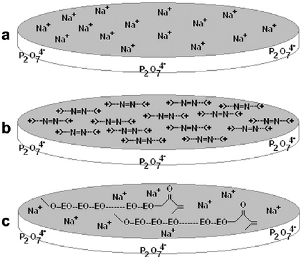Aug 8 2017
3D printing has touched nearly every industry today. What the average consumer or hobbyist may not be aware of though is that within each of those industries, 3D printing and other progressive technologies are creating entirely new realms. Science and medicine are a prime example, demonstrating so many different ways that 3D printing can change lives—and will continue to do so in the future.
 Laponite surface (Credit: ResearchGate)
Laponite surface (Credit: ResearchGate)
The use of hydrogels in 3D printing is helping research teams around the world create new applications in areas such as artificial blood networks for dentistry, knee implants, soft robotics, and so much more. Because of their compatibility in the human body, hydrogels are useful in bioprinting. For scientists though, the challenge has been in refining this material for use in the 3D printer. Most research teams interested in using hydrogels have persisted in learning to 3D print them because of the ability to customize items like implants, offering patient-specific devices that can be so much more effective.
Now, researchers are furthering the study of hydrogels in 3D printing as well as expanding their uses. ‘Development of a clay based bioink for 3D cell printing for skeletal application,’ was authored by researchers hailing from Technische Universität Dresden and the University of Southampton. Published recently in BioFabrication, the paper goes into detail about the potential for using the versatile material in tissue engineering—one of the hottest areas of science today as researchers hope one day to create entire organs for transplant.
“Three-dimensional printing of cell-laden hydrogels has evolved as a promising approach on the route to patient-specific or complex tissue-engineered constructs,” state the researchers. “However, it is still challenging to print structures with both, high shape fidelity and cell vitality.”
Because of such challenges in printing, the team has begun using Laponite, an artificial nanosilicate clay. With this material they are able to 3D print new scaffolds. The bioink is created through a combination of both alginate and methylcellulose which facilitate easier 3D printing.
“Following extrusion, approximately 70%–75% of printed immortalised human mesenchymal stem cells survived and cell viability was maintained over 21 days within the plotted constructs,” state the researchers in their paper. “Mechanical properties of scaffolds comprised of the composite bioink decreased over time when stored under cell culture conditions.”
The team goes on to point out that Laponite offers numerous benefits, including that of ‘favorable drug delivery properties.’ They used both bovine serum albumin and vascular endothelial growth factor in the bioink.
“We demonstrate that the release of both growth factors significantly changed to a more sustained profile by inclusion of Laponite in comparison to an alginate-methylcellulose blend in the absence of Laponite,” stated the researchers.
Overall, they found that using Laponite allowed for better fabrication technique, improved ‘shape fidelity,’ and the release of active agents.